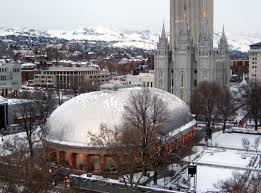Salt Lake Tabernacle
Sometime after the members of The Church of Jesus Christ of Latter-day Saints settled the Salt Lake Valley in Utah, church president Brigham Young envisioned a building able to seat a large congregation. At the April 1863 general conference, Daniel H. Wells, a counselor to President Young, announced plans to build a tabernacle that would comfortably seat several thousand people. Up until that point, a series of open-sided boweries and an Old Tabernacle had housed religious and public gatherings on Temple Square.
Under the direction of Young, Church architect William H. Folsom prepared plans for a structure 150 feet wide and 250 feet long with semicircular ends and a peaked roof. Construction began in 1864 with the cornerstones and forty-four sandstone piers that would support the roof.
Young appointed Henry Grow, a bridge builder, to oversee the construction of the tabernacle. Young wanted the roof to be self-supporting so that pillars would not obstruct the view of the audience. Grow modified a type of lattice truss used in bridge construction into elliptical arches that were self-supporting and spanned the width of the building. The trusses were constructed of timbers pegged together with wooden dowels split and wedged at each end. Cracked timbers were wrapped with green rawhide, which contracted and secured the timber when it dried. The finished roof structure was nine feet thick.
The interior was lathed and plastered, with cattle hair mixed into the plaster to give it strength. The pine benches were hand painted to look like oak and the wooden pillars supporting the balcony were painted to resemble marble.
Church architect Truman O. Angell, who replaced Folsom in 1867, added an interior balcony in 1869–1870 that seated 3,000. The tabernacle was now capable of seating about 10,000. The balcony also improved the building’s acoustics, which are still considered remarkable. The Tabernacle was used for general conference in October 1867. It was under construction from 1863 to 1875 and dedicated in October 1875.
The rostrum area needed extensive remodeling to meet the needs of the growing church, which was done in 1882, 1933, and 1977. Some of the seating capacity was sacrificed in these remodels. A baptismal font was added in 1890. The shingle roof was replaced with aluminum in 1947 and a basement was added in 1968.
From 2005 to 2007, the building was closed for extensive renovations, which included seismic retrofitting. The pine benches were replaced with oak and legroom between benches was increased from nine to fourteen inches and approximately 1000 seats were lost. The baptismal font in the basement was removed. Three recording studios, new dressing rooms, and a music library for the Tabernacle Choir members were created in the basement. The rostrum was again remodeled. It was rededicated during general conference in March 2007.
In 1970 it was designated as a National Historic Landmark and the following year as a National Civil Engineering Landmark.
The Tabernacle is home to the 11,623-pipe Tabernacle Organ. The original organ was made by Joseph H. Ridges and contained 700 pipes. A few of the original pipes are still used. The current organ was made by G. Donald Harrison in 1948 and was renovated and restored in 1989. It is one of the largest organs in the world. The image of the organ with its golden pipes of round wood staves was an image the Church of Jesus Christ used for many years, especially on the cover of its hymnbooks.
The Tabernacle is also home to the Tabernacle Choir at Temple Square. The Choir has broadcast its weekly “Music and the Spoken Word” from the building since 1929. It is located on the west side of Temple Square in Salt Lake City.
